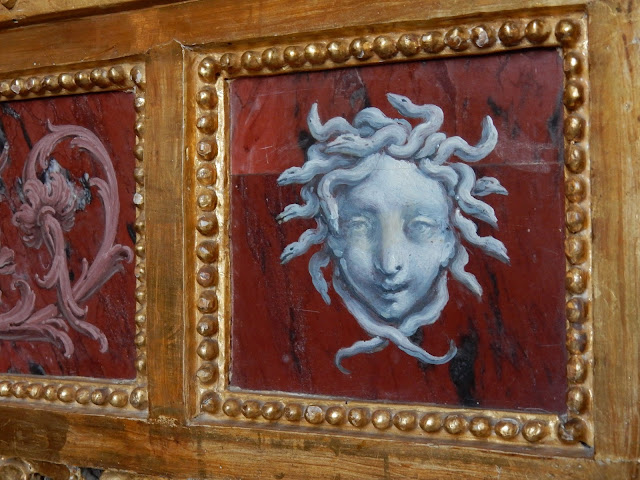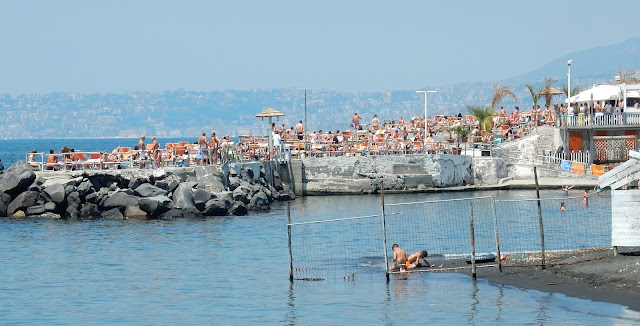I'm getting way behind in my reportage, but rather than skip a bunch of days to where I am now, I think I'll just continue sequentially, since it helps me to remember what I did on each day. I've actually now been in England for a week, but this one's about getting here.
Awoke at dawn to catch a taxi to the train to the airport, where the usual confusion and stress of being in transit mode set in. For someone who loves traveling, i really don't much enjoy the in transit part. The watchfulness, stressing over time frames, and standing in lines are not my idea of fun. Once I'm in my seat and moving it's ok, but the preamble part, not so much. I also stress on finding myself in a new place where I have no orientation, looking at maps and trying to figure out where to go. The computer is great when you have WiFi, and the maps supposedly were going to work on my phone (but have not) so I sometimes get a good map from internet and leave the page open on the laptop, and will get it out for reference when needed. That's worked pretty well, with the exception of Venice, where the addresses are not always correctly entered in the database.
 |
In the Rome airport a noisy groom's party (with him in a bridal gown) looked like they'd been going all night1
|
Anyways, made it through all the airport hoopla and got on the plane, a cheapie hopper from Rome to London. There are now a whole bunch of smaller airlines competing for business ferrying people from point to point in Europe, which means there are really low fares (especially if you book in advance!) on planes that are bare bones, but who cares if it's only a two hour flight. Vueling, Easy Air, Ryanair, you can find a bunch of them online.
 |
| Not sure what that's all about. Kinky Brits! |
As we were approaching Gatwick airport, I was struck by the difference between the rural landscape below and that of the U.S. From the East Coast to the Rockies, the landscape is a grid of roads and field divisions that is very regulated on a North East South West pattern, and you can easily see that it stretches for miles that way. In England (and most of Europe) that grid is nonexistent, with fields and roads that are built to accommodate for natural features, rather than the other way around.
 |
| English countryside has none of the mechanical gridding that dominates the US |
Touched down at Gatwick and did the usual passport stuff, noticing how many closed circuit cameras there were everywhere. England is supposed to be the most monitored country in the world for video, and you do see it everywhere- little notices that tell you you're being watched by big brother. Somewhat reassuring, but somewhat disturbing too. Got on the bus to transfer to Heathrow, where Marianne was coming back to meet me after going home for a week to wrap up the school year at her job (she's a school nurse at a middle school.) Didn't have to wait too long before she came in, and we made our way to the car rental place, which is what we'd decided to use to get down to our friend Robert's place in Wiltshire, near Bath. We were rather put off by the rental price jump for insurance; Marianne thought she'd found a car for $20 a day, but then they hit you with "Oh, the insurance fee is $60!" We almost decided to blow it off and take a train, but after some foot stamping and negotiation, we got a decent car for a decent price (around $50/ day all told) and set out.
 |
| Traffic jam on the A3- feels just like home! |
I was amazed at how shifting on the left side didn't really feel all that strange (we got a manual- they're cheaper) but the left side of the road thing is definitely a challenge, and more than once I found myself on the wrong side, especially when making a right turn. English roads are funny- they seem so rural everywhere- even the big motorways are surrounded by trees, and they don't have billboards, so it almost seems like you're in a green tunnel. Once you're on the smaller roads, they are very narrow and hemmed by greenery, and people park in places that make the road only one car's width, so you take turns coming through. Traffic accidents here must be real show stoppers, as there's frequently no alternative route, and if it's only one lane and that's blocked, well….
 |
| Stonehenge, taken from the window of the car as we passed by- it's that close! |
We were also really happy to have gotten a car with SatNav (GPS), since Marianne is not much of a map reader, and I was doing the driving. In England, the little postal codes in the address is actually a unique coordinate for any building, so the computer can tell you exactly where you need to go- including the tiny country lanes. On our way down to Robert's, we were surprised to see Stonehenge just off the road we were on, looking rather small (as in Spinal Tap!) We passed by and soon made it to Frome (rhymes with "broom"), squeezed through the streets there and found Robert's country hideaway out in the middle of fields, next to a dairy farm. Robert and Andrew (they're a couple) live there in very peaceful surroundings, much of which Andrew has built up over time. They just recently added a lake (we'd call it a pond, but it's his lake!) and the house is a delightful little farmhouse that's been made very cozy for the two of them.
 |
| The approach to Robert and Andrews house. Without the SatNav we never would have found it! |
The whole reunion thing was kind of a last minute idea, borne of us traveling to England, but bringing together some far flung pals who had a tight knit group that centered around the punk music scene in LA during the late 70's and early 80's. There were 10 of us altogether, most of whom had known each other for over 30 years. Two of us, Robert and Alan, had moved to the UK a number of years ago, and our reunions are few and far between, so it was a real joy to get together and share stories and memories. We all settled in and Andrew showed me some of his art collection around the house- very nice pieces that included watercolors of the area, and some really good portraits and landscapes by a great-aunt of his.
 |
| Andrew showing us the lake he had put in. Not too shabby! |
Ate a yummy dinner prepared by Robert (with help), and talked until one AM.

















































